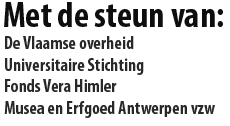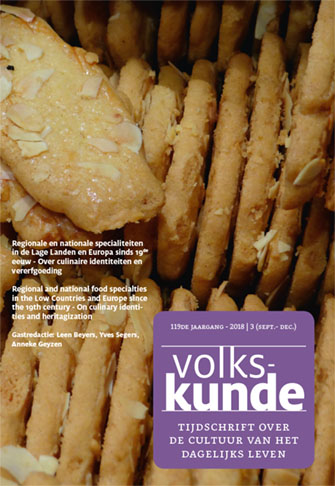LOÏC BIENASSIS
La place et les usages du culinaire
De plaats van en vertogen over culinaire cultuur in de regionalistische Franse tijdschriften van de Belle Epoque (einde 19de- begin 20ste eeuw)
In welke mate heeft de regionalistische beweging in Frankrijk begin twintigste eeuw bijgedragen aan de ‘territorialisaton’ van verschillende gerechten en producten, of anders uitgedrukt, aan de totstandkoming van streekspecialiteiten? De invloed van deze beweging wordt regelmatig aangehaald door onderzoekers, maar is nooit echt geanalyseerd en tevens ontbreekt een klare chronologie. Deze bijdrage steunt op de analyse van meerdere tijdschriften, uitgegeven tijdens de Belle Epoque, een periode
waarin het regionalisme opkwam en confirmeerde.
Deze bijdrage toont aan dat de meeste tijdschriften in de bestudeerde periode relatief weinig aandacht besteedden aan eetcultuur. Er zijn daarbij twee benaderingen: een eerste meer emotioneel en affectief, schakelde elementen uit de eetcultuur in bij het
creëren van een identiteit; een tweede meer utilitair beklemtoonde het economische en toeristische belang van streekproducten en gerechten voor de Franse provincies en regio’s.
Op een meer fundamenteel niveau versterken deze twee invalshoeken elkaar, evenwel wanneer ze de regionale keuken inschakelden in een discours dat gekenmerkt wordt door bezorgdheid en ongenoegen over de teloorgang van het Franse platteland en het verdwijnen van typische rurale tradities.
NELLEKE TEUGHELS
Eendracht maakt macht?
Unity makes strength? Culinary expressions of identity and power at the Brussels International Exhibition of 1935
This paper explores the complex semiotic meanings embedded in the choice and the representation of food served at the official banquets at the Brussels’ World Exhibition of 1935.
The aim is to investigate how food was used by the organizing elite as a political and diplomatic means of expressing cultural identity, regional diversity and national unity. How did Belgium shape its national identity in this diplomatic arena? How did the country deal with the increasing tensions between the Flemish and Walloon linguistic communities? And to what extent do local economic factors possibly play a role in the
choice for certain ingredients or dishes?
SAAR NIERMEIJER
Aardappelen met een “brave Nederlandse gehaktbal” en spruitjeslucht
Potatoes with a decent Dutch meatball and a whiff of sprouts air
The ‘bad’ Dutch cuisine and the tastelessness of ‘the Dutchman’, they form recognizable and seemingly self-evident elements of contemporary Dutch culture. Even in Dutch food historiography, this negative assessment of the Dutcheating habits is often repeated or even endorsed, while the construction of images underlying this myth
remains unquestioned. Therefore this article does focus on how culinary journalist Wina Born contributed to the creation and reproduction of this negative national self-image in her texts for the magazine Avenue between 1965 and 1980. During the major cultural and culinary changes of the sixties and seventies in the Netherlands Born was an important mediator between the growing middle class, ‘foreign foods’ and gastronomy.
In her texts for Avenue she developed a cosmopolitan and critical culinary discourse within which taste hierarchies were made and culinary capital was allocated to ingredients, restaurants and foreign cuisines. A qualitative analysis of her culinary
reports and reviews shows that within this discourse ‘the Netherlands’ always functioned as the unique ‘bad’ opposite of the refined and often ‘foreign’ eating habits she advised to her readers. In this way the article provides insight into the functioning
of the negative national self-image as strategy for social distinction. By rejecting the Dutch cuisine and the taste of ‘the Dutchman’, users of the self-image such as Born, show that they, in contrast to the average Dutch person, are able to distinguish what is
tasteful and what is not. In addition, the article shows the flexibility and longevity of the myth, because, even when the eating habits of the Dutch began to differentiate more in the seventies, the negative national selfimage retained its distinctive function in the culinary discourse of Born.
ALBENA SHKODROVA
Investigating yhe history of meanongs of a dish
Hoe de betekenis van een gerecht doorheen de tijd verandert
Een enactivistische benadering van de biografie van de Russische salade in Bulgarije in de 20ste eeuw
Dit artikel onderzoekt de geschiedenis van het gerecht “Russische salade” en de betekenis ervan in Bulgarije in de 20ste eeuw, namelijk de opkomst ervan als een feestelijk gerecht met de status van een culinair icoon, overgenomen van modieuze Russische immigranten, waarna die status geleidelijk verloren ging en het gerecht werd opgenomen in de doordeweekse lokale voedseltraditie. Om deze evolutie te verklaren past de auteur een voor food studies experimentele methode toe: de enactivistische theorie, die in de voorbije jaren door cognitieve filosofen werd ontwikkeld. Zij betoogt dat het niet-reducerende naturalistische kader van deze theorie
een antwoord kan bieden op tot nu toe ongrijpbare en belangrijke vragen, zoals de dynamiek van sociale praktijken en de rol van het lichaam bij de betekenisgeving.
Door de enactivistische benadering te gebruiken bij het bestuderen van de geschiedenis van de betekenissen van een gerecht, toont zij het potentieel ervan aan om het leven van sociale praktijken en autonomie van historische processen van
betekenisgeving te verklaren.
GREET DRAYE
Bollen en boterkoeken
‘Boules’ and butter biscuits The heritagisation of two Dixmude specialties
Visit Flanders, the Flemish-Brussels Tourist Office, promotes ‘IJzerbollen’-
a kind of pastry with pudding – and ‘Boterkoeken’- buttery viennoiserie – as well known specialties from the small town of Diksmude in West-Flanders. As if they have always
existed and everybody associates them with Diksmude. That is not the case: ‘Boterkoeken’ enjoy a much wider fame than ‘IJzerbollen’. Research in cooking books, culinary periodicals, picture libraries and oral history deciphers how both sweets
became to be seen as heritage and hints on explaining the difference. Culinary identities are created, as are all identities. The association between a dish and a location is manmade. The creation of culinary identities is to be seen as heritagisation. That term is used to describe the process within which a community redefines the
meaning of (im)material heritage. That new meaning provides the community with an identity. The process often takes place in times of uncertainty and change, to create
a hold. In the case of food, a dish or an ingredient gets an addition referring to a place, home, or ‘better days in the past’. The context of the heritagisation is variable, as are the communities that act within the process. Conflicting identities are possible. Nothing is set forever. ‘Boterkoeken’ is a registered trademark since 1978. One determined
family of bakers took care of that registration. Since 1978 there has been nothing but continuity in the process of heritagisation. In the case of the ‘IJzerbollen’ the heritagisation community was far from close. At the same time, the heritagisation
timeline shows gaps: moments without the pastry as heritage. In 2011 the name ‘IJzerbollen’ got protection. That moment marked the humble start of the pastries renown. The power of a mark – in its widest sense – cannot be underestimated in the
process of heritagisation, as can’t a close and growing community and the continuity of the process.
CHANTAL BISSCHOP en ARNE DE WILDE
Gebakkelei over de Geeraardsbergse mattentaart. De identiteitsconstructie en een streekproduct
Wrangling about the ”Geraardsbergse mattentaart”
The identity construction of a regional product
In this article the evolution of the identity construction of the ‘Geraardsbergse mattentaart’ is being analyzed. The authors explore the multiple, and often contradictory, histories and cultural dynamics instigated by this regional product.
After a short factual description of the local pie (and its recipe), they present
a historical sketch of the culture of the mattentaart, focusing on pivotal points in its evolution. In the second part, the authors analyze – on the basis of historical and journalistic sources, visual material and interviews – the discursive dynamics the mattentaart has initiated and the heritagisationstrategies operationalized to strengthen the identification claim on the product. The central question guiding their analysis is: How can a seemingly banal cake activate and invigorate an entire community and generate a never-ending stream of stories? It is argued whether precisely this processof heritagisation, which is surely applicable to other regional products,
constitutes the specificity of the culture of the mattentaart.
VEERLE VANDENDAELEN, LEEN BEYERS, SOFIE DE RUYSSER
Pleidooi voor meerstemmigheid. Antwerpse Handjes en Jodenvervolging
A plea for multiperspectivity
The Antwerp Hand cookies and the persecution of Jews
Jos Hakker was an enterprising confectioner in the Provinciestraat in Antwerp in 1934 when he launched a new specialty: the Antwerp Handje. A box of Antwerp Hand cookies is the most famous tourist souvenir of the city of Antwerp today. When you
open a box of Antwerp Handjes, you discover – next to the cookies – the legend of the giant Antigoon who had lifted toll on the River Scheldt until the Roman soldier Brabo chopped off his hand … after which the city of Antwerp started to flourish thanks to free trade. Less known is the fact that Jos Hakker was of Jewish Dutch origin and that he and his family were victims of the persecution of Jews during the Second World War.
This aspect of history has never been discussed in the broad marketing and communication concerning the Antwerp Handje. The marketing of regional products
asks for some multiperspectivity. All the more because the Antwerp Hands cookies became truly successful in the 1950s and 1960s, at a time when even Jews who survived the war kept silent about the Holocaust. The reasons for this lack of attention for the inventor can be understood from this context, but today we think it is extremely relevant to tell not only the legend but also the story of Jos Hakker, and particularly the story of his persecution and his resilience as a Jew and a confectioner in Antwerp.
That is why we strongly suggest a new text in the brochure about the Antwerp Hand cookies.


